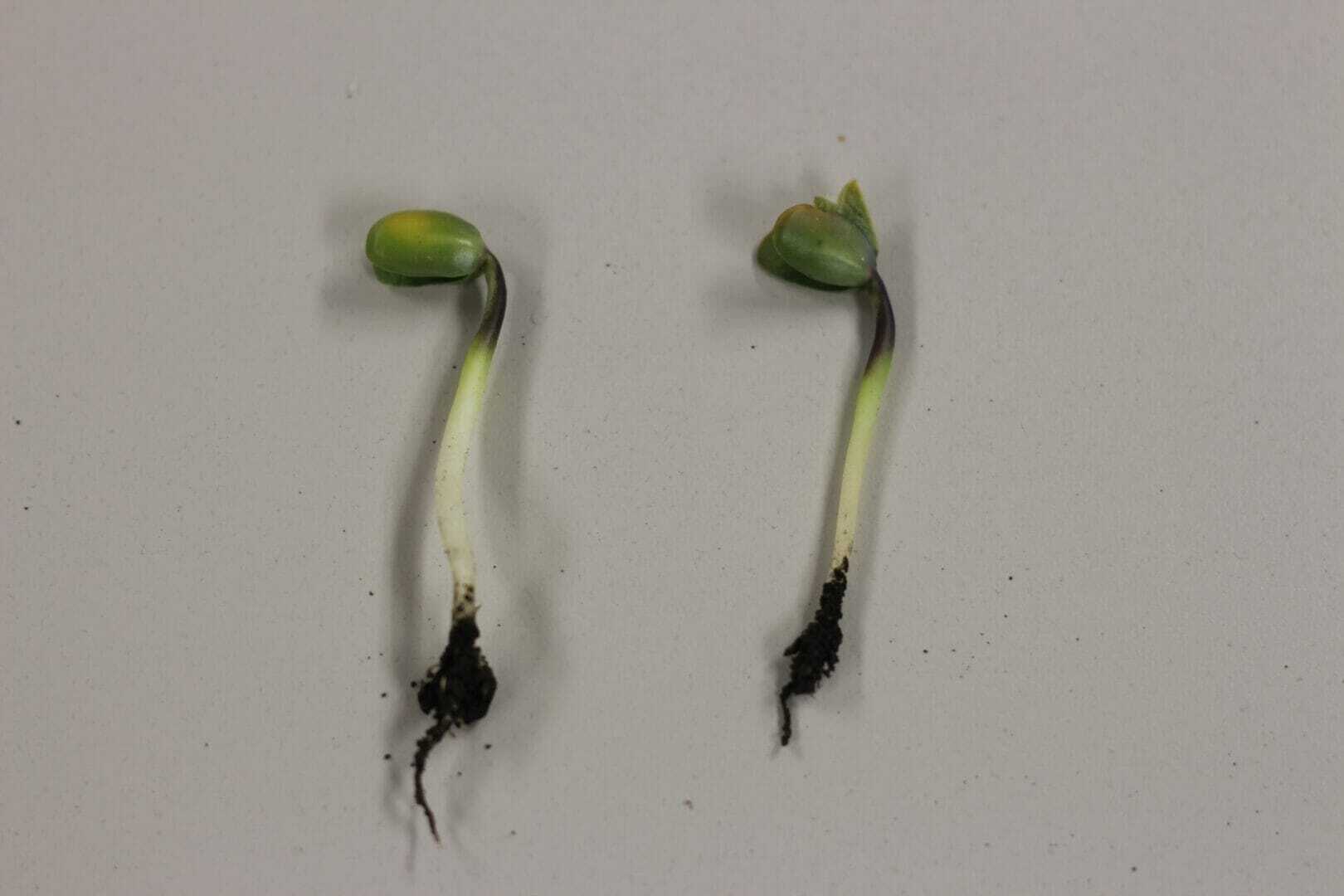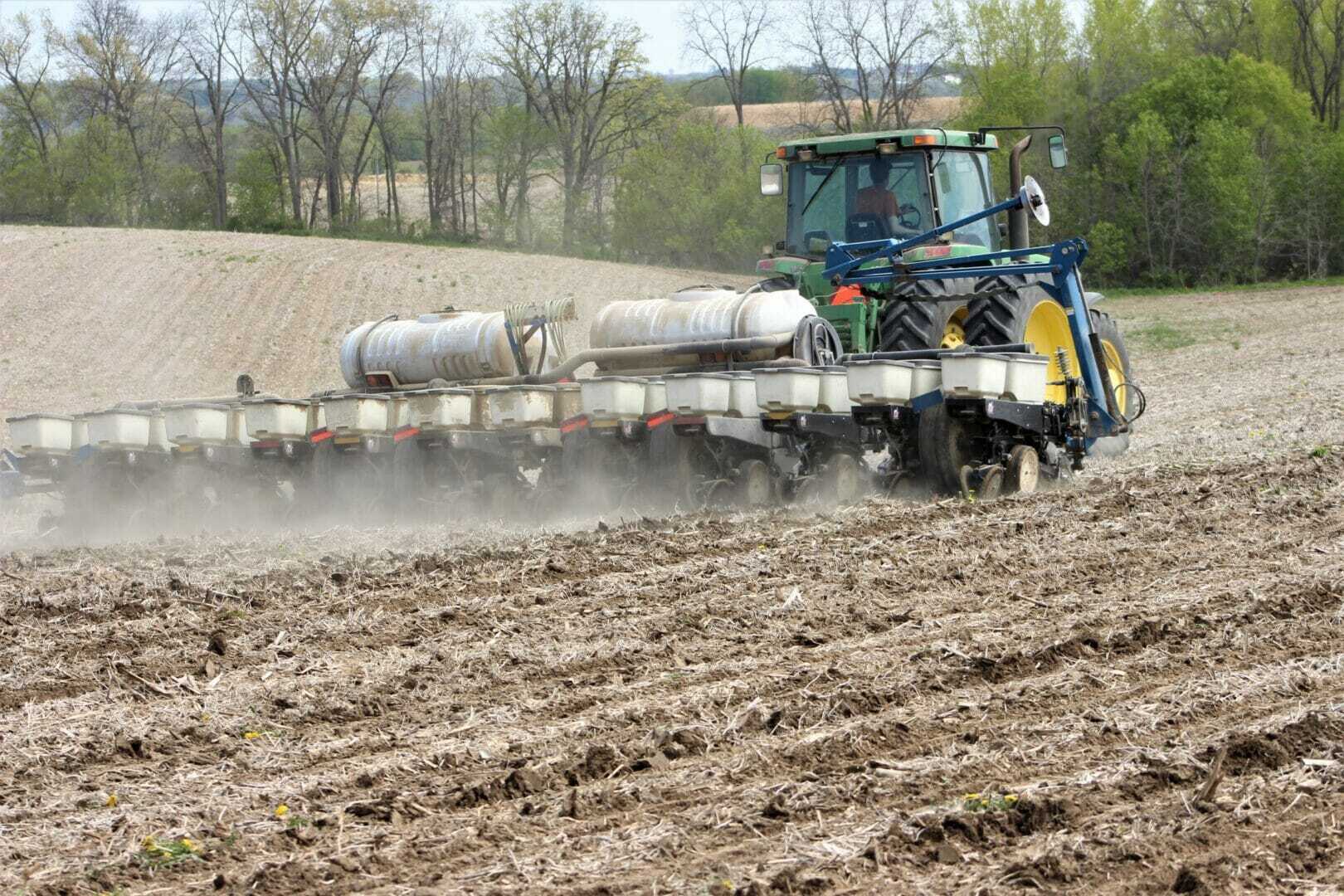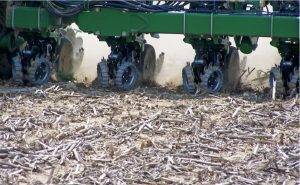-
Latham Hi‑Tech Seeds
Frost Damage in Corn & Soybeans
 Phil Long discusses the implications of an early-season frost in both corn and soybeans. Tune in to learn if your crop was affected. #LathamSeeds:15 — Welcome:35 — Topic introduction & indicating factors3:30 — Frost damage in corn8:50 — Frost damage in soybeans
Phil Long discusses the implications of an early-season frost in both corn and soybeans. Tune in to learn if your crop was affected. #LathamSeeds:15 — Welcome:35 — Topic introduction & indicating factors3:30 — Frost damage in corn8:50 — Frost damage in soybeans -
Latham Hi‑Tech Seeds
Early Season Frost or Freeze Damage in Corn

The virtue of patience is most beneficial when the time comes to assess frost or freeze damage in early-season corn. Once a frost or freeze event takes place, do an initial assessment of your field and wait 3-5 days before making any final decision on how to proceed. Young corn plants can tolerate cool temperatures up to V5 since the growing point is still below the soil surface. Early season damage caused by the cold temps does not show up immediately as the cells that get broken from the freezing moisture inside the plant may look normal the first morning after a freeze. Depending on the actual low temperatures, symptoms may take a day or so to appear.
Frost Damage Assessment
- Identify Location – Note field locations that experienced the cold temperatures. Also note the lay of the land in those fields such as low spots, hill tops, general slope direction.
- Soil Moisture – Record the soil moisture levels across the entire fields, possible dry hill tops and wetter low areas. Moist soil can offer some protection.
- Soil Temperature – Check soil temp in different location across the field.
- Soil Type – Be conscious of the soil type. Sandy soil cools much faster than silty or clay soils.
- Weather Data – Utilize location weather station info to determine the lowest temperature and duration of that temperature.
Frost Damage

Corn at V4 damaged from frost event. Above-ground tissue is dead (brown) but the growing point was still below-ground and is alive (white-yellow tissue) Young corn plants can tolerate some low temperatures and still survive and achieve high yields. The growing point of the plant remains under the soil until the plant reaches V5. At this stage, you will see five leaf collars showing around the stem. You may have more leaves visible, so count the collars for accurate assessment of crop stage. Low temperatures that do not fall below 30 degrees generally just damage the exposed leaves and do not hurt the growing point. However, recovery of these plants may take some time (up to a full week) depending on weather after the frost. Below is a photo from the Iowa State University Integrated Crop Management newsletter showing a viable growing point after a frost event.
Frost Damage Management
- Wait 3 to 5 days with temps above 70 degrees. Wait even longer with lower temperatures.
- Assess percentage of damaged plants and survival rate prior to any replant decision.
- Allow plants to recover prior to any herbicide or fertilizer applications, this may take a week to 10 days.
- Note the amount of leave tissue lost and how it will affect your crop staging.
- Loss of two leaves in 4 leaf corn will still be classified as V4. This becomes important for later application of herbicides. Keep the leaf loss in mind when staging corn for later applications to assure you are not past a window that may cause herbicide injury.
Freeze Damage
If you experience low temperatures of 28 degrees or lower for a prolonged period of time, most all the plants in a field will show significant damage. These extended low temperature situations become more critical for assessment. You may see variation across a field due to soil type, soil moisture content or the amount of residue on the field. Corn damaged by a hard freeze will still need patience for assessment. Assess all fields after hard freezing temperatures, even those that have not emerged yet. Check soil temps at 2” level soon after a freeze for a sound understanding of the scope of damage to a field.
Freeze Damage Assessment
- Soil Temps – Check soil temps at 2” level in multiple locations of the damaged field to gain knowledge of how widespread the damage has occurred. This needs to be recorded early.
- Patience – Wait 3-5 days to allow the full expression of effects of the freeze.
- Plant Tissue – Slice open young plants and observe the growing point. Brown and water-soaked tissue vs white or green tissue. See earlier photo for viable plant.
- Dig Un-emerged Seeds – Hard kernels remain viable while soft/mushy kernels will not germ or have the energy to push the sprout through the soil.
The photo on the left shows leafing out underground due lack of energy of seedling. The photo on the right shows damage to the coleoptile that will result in shoot not having capacity to push through the soil. Photo courtesy of RL Nielsen, Purdue Univ.
Freeze Damage Management
- Wait 3 to 5 days with temps above 70 degrees, longer if lower temps.
- Slice open emerged plants and determine percentage of population damaged.
- Dig up un-emerged seedlings and kernel assess viability and determine percentage of population damaged.
- If stand damage is substantial, assess the costs and benefits of leaving the stand versus replanting.
Patience is key when assessing damage from a frost or freeze event. If you allow time for the crop to respond to the event, you will make better decisions for that damaged field.
-
Latham Hi‑Tech Seeds
Ask The Agronomist: Prepping The Seed Bed

How much tillage is too much? Phil Long discusses proper seed bed preparation and the importance of protecting moisture in the ground. #AskTheAgronomist
:20 – Welcome
1:40 – Topic introduction
3:00 – GDUs, rainfall averages and soil temperatures
4:40 – Soybean germination
5:15 – Conserving moisture in the seed bed
6:40 – Optimal seed depth
7:27 – Soil sealing
10:36 – Cover crops and early termination
11:35 – Final thoughts
-
Latham Hi‑Tech Seeds
Planting and Cold Temps

Seeds absorb moisture within hours after planting and begin the germination process almost immediately. When corn seeds absorb water colder than 50°F, imbibitional chilling or cold shock may occur.
These three symptoms of cold chill may be evident at emergence, during the growing season and at harvest time:
- Absorbing cold water causes the cell membranes to rupture and release fluids that provide food sources for soil pathogens. These can invade developing seedlings and dramatically harm the germination.
- When a seed imbibes cold water, the early season vigor of young corn plants may be negatively impacted. Weak root systems with gnarled primary roots might result.
- Wet soils drain kernels of their energy reserves, so seedlings that struggle for a week or more to emerge may have erratic emergence and uneven growth. Many of these fields experience disappointing yields at harvest due to reduced stands and decreased seedling vigor.
Call into the Latham® office and we will get you connected with one of our agronomists. Happy Spring!
-
Latham Hi‑Tech Seeds
#AskTheAgronomist: Planting Depth
 It pays to double check seeding depth! Tune in as Phil Long discusses ideal seeding depth for both corn and soybeans. #AskTheAgronomist:20 – Introduction:50 – Topic overview1:50 – Corn: Why 2 inches?2:00 – Imbibitional phase3:13 – Nodal root development6:25 – Soybean seeding depth7:25 – Soybean seed size9:15 – Final thoughts
It pays to double check seeding depth! Tune in as Phil Long discusses ideal seeding depth for both corn and soybeans. #AskTheAgronomist:20 – Introduction:50 – Topic overview1:50 – Corn: Why 2 inches?2:00 – Imbibitional phase3:13 – Nodal root development6:25 – Soybean seeding depth7:25 – Soybean seed size9:15 – Final thoughts -
Latham Hi‑Tech Seeds
Effects of Early Planting
 Do cool soils affect corn or soybeans more? Tune in as Phil Long discusses how cold temps affect corn and soybeans differently. #LathamSeeds0:12 — Welcome & topic introduction2:00 — Days to emerge5:50 — Corn cold injury potential8:15 — Soybean cold injury potential10:35 — Forecast of opportunity
Do cool soils affect corn or soybeans more? Tune in as Phil Long discusses how cold temps affect corn and soybeans differently. #LathamSeeds0:12 — Welcome & topic introduction2:00 — Days to emerge5:50 — Corn cold injury potential8:15 — Soybean cold injury potential10:35 — Forecast of opportunity -
Latham Hi‑Tech Seeds
Planting Speed Matters

Dial in your planter speed this spring season. Phil Long discusses the importance of planter speed in relation to efficiency, singulation and yield potential. #AskTheAgronomist #LathamSeeds
:30 – Welcome & Topic Introduction
1:30 – Scenario 1
2:40 – Efficiency & yield potential
6:30 – High speed planters
7:20 – Singulation & speed
10:05 – Final thoughts -
Latham Hi‑Tech Seeds
Optimize Yield with a Great First Pass

 Controlling organic matter or residue to prepare an ideal seed furrow is crucial for attaining optimal seed emergence. Essentially, the planter pass is key to optimizing yield potential for each corn plant.
Controlling organic matter or residue to prepare an ideal seed furrow is crucial for attaining optimal seed emergence. Essentially, the planter pass is key to optimizing yield potential for each corn plant.There are a few planter attachments to consider for controlling residue. Some planters may come equipped with “fixed” row cleaners that control the depth of residue removal using a manual pin or screw adjustment. This option is better than nothing, but one undesirable feature is that you must get out of the tractor cab to make an adjustment to fit the changing conditions when the contour of the field changes. If you have rolling farm ground, this can become a very tedious process. It’s also important to ensure you aren’t disturbing topsoil while removing necessary clods or residue.
Another option is “floating” row cleaners, and this is my recommendation. The benefit of a floating versus fixed row cleaner is when the contour of the field changes, it adjusts to the changing conditions. This option assures that you are only removing residue and minimally disturbing topsoil.
If you make the investment in floating row cleaners for your planter, take a couple of extra steps to ensure you’re clearing a wide enough path to let the gauge wheels run within the furrow. You could add treader wheels, which attach to the outsides of the row cleaners, to provide optimal depth control. Although your row cleaners may be floating, it’s critical they don’t dig too deep.
To really dial in your row cleaners as you make your pass through the field, add air adjust cylinders to each row cleaner. This allows you to adjust your row cleaners from the cab. Since it’s easy, you will adjust when you should. To make a pressure adjustments with those air cylinders, move the lever in the cab to apply lift-pressure or down-pressure to the cylinders, so they clean the way you want. You can choose to be more aggressive or to run lighter. Making such adjustments prevents seedling diseases as well as late emergence from heat and moisture loss. It also prevents nutrients from being tied up by residue.
The most important pass made in the field is the first pass with the planter. If we don’t get this correct, the rest of the management practices we apply throughout the season aren’t effective and will hinder return on investment (ROI).
Working with trusted advisors and a cutting-edge precision ag platform allows you to monitor ROI. A precision ag program like Latham’s Data Forward helps you track crucial investments to your operation. We want to be a resource for you when it comes to making precision ag decisions. Give Latham’s Precision Agronomy Advisors a call to implement performance benchmarking, on-farm trials, and reporting, or to evaluate ROI before making significant investments in your precision equipment.
-
Latham Hi‑Tech Seeds
#AskTheAgronomist: Nitrogen Application

Are you getting the biggest bang for your buck from your nitrogen application? #AskTheAgronomist
1:06 — Welcome & topic introduction
2:26 — Nitrogen 4 R’s: right source, right time, right place
5:30 — Right rate
9:36 — On-farm research with Data Forward -
Latham Hi‑Tech Seeds
Update on XtendFlex® Soybeans

Reports from around the seed industry indicate that Bayer CropScience is close to being granted approval for its new XtendFlex® soybean system. This new technology will be the first triple-stack soybean trait with tolerance to glyphosate, dicamba and glufosinate (Liberty®) herbicides. Pre-launch ads from Bayer cite advanced genetics and greater flexibility for weed management options.
Latham Hi‑Tech Seeds in 2019 was granted a sneak peak of six XtendFlex soybeans at our research farm near our headquarters in Alexander, Iowa. This test was conducted under the guidelines of an EPA-stewarded trial where the resultant soybean crop was harvested for data purposes but was then destroyed, so it could not reach the global supply chain.
The six soybeans we tested ranged from 1.9 to 3.0 in maturity and were compared to 14 soybeans that were in our lineup at that time. The test was split by herbicide tolerance. The same six XtendFlex lines were tested against 14 Liberty-tolerant products, including Enlist E3™, straight LibertyLink® and LLGT27™. They were also tested against 14 soybeans that were all tolerant to glyphosate: Roundup Ready® 2 Yield (RR2Y), Roundup Ready® Xtend®, Enlist E3 and LLGT27.
 On the Liberty side of the test, the six XtendFlex soybeans ranged in yield from 56.75 to 65.74 bushels per acre (bu/A) where the 14 current products went from 47.11 to 67.90 bu/A. The overall yield average of XtendFlex soybeans was 60.58 whereas the current products averaged 60.30 bu/A.
On the Liberty side of the test, the six XtendFlex soybeans ranged in yield from 56.75 to 65.74 bushels per acre (bu/A) where the 14 current products went from 47.11 to 67.90 bu/A. The overall yield average of XtendFlex soybeans was 60.58 whereas the current products averaged 60.30 bu/A.On the glyphosate-tolerant side of the trial, the yield of XtendFlex products ranged from 55.84 to 64.13 bu/A; the average yield was 61.67 bu/A. The yield of current products ranged from 54.70 to 69.37 with an average of 62.33 bu/A. NOTE: Due to late planting and other environmental factors, the later-maturing soybeans (2.8 to 3.0) in both sides of the trial struggled to reach full maturity and really suffered from a yield standpoint.
In general, I am pleased with the results of this trial. This was one location for only one year, but it did tell us that the first wave of the XtendFlex products tested in 2019 performed very well.
Pending full approval, there should be some very solid lines available for Latham farmer-customers for 2021 commercial planting! The last hurdle for full global approval of XtendFlex soybeans is the European Union at press time of this article. Bayer is optimistic this will be resolved in time for planting. We’ll keep you posted when we know more about this exciting new technology!


